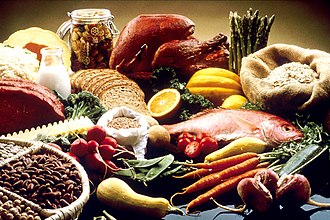 Global Information
Global InformationHuman food information
Human food is food which is fit for human consumption, and which humans willingly eat. Food is a basic necessity of life, and humans typically seek food out as an instinctual response to hunger; however, not all things that are edible constitute as human food.

Humans eat various substances for energy, enjoyment and nutritional support. These are usually of plant, animal, or fungal origin, and contain essential nutrients, such as carbohydrates, fats, proteins, vitamins, and minerals. Humans are highly adaptable omnivores, and have adapted to obtain food in many different ecosystems. Historically, humans secured food through two main methods: hunting and gathering and agriculture. As agricultural technologies improved, humans settled into agriculture lifestyles with diets shaped by the agriculture opportunities in their region of the world. Geographic and cultural differences have led to the creation of numerous cuisines and culinary arts, including a wide array of ingredients, herbs, spices, techniques, and dishes. As cultures have mixed through forces like international trade and globalization, ingredients have become more widely available beyond their geographic and cultural origins, creating a cosmopolitan exchange of different food traditions and practices.
Today, the majority of the food energy required by the ever-increasing population of the world is supplied by the industrial food industry, which produces food with intensive agriculture and distributes it through complex food processing and food distribution systems. This system of conventional agriculture relies heavily on fossil fuels, which means that the food and agricultural system is one of the major contributors to climate change, accountable for as much as 37% of the total greenhouse gas emissions.[1] Addressing the carbon intensity of the food system and food waste are important mitigation measures in the global response to climate change.[2][3]
The food system has significant impacts on a wide range of other social and political issues, including: sustainability, biological diversity, economics, population growth, water supply, and access to food. The right to food is a "human right" derived from the International Covenant on Economic, Social and Cultural Rights (ICESCR), recognizing the "right to an adequate standard of living, including adequate food", as well as the "fundamental right to be free from hunger". Because of these fundamental rights, food security is often a priority international policy activity; for example Sustainable Development Goal 2 "Zero hunger" is meant to eliminate hunger by 2030. Food safety and food security are monitored by international agencies like the International Association for Food Protection, World Resources Institute, World Food Programme, Food and Agriculture Organization, and International Food Information Council, and are often subject to national regulation by institutions, such as the Food and Drug Administration in the United States.
- ^ SAPEA (2020). A sustainable food system for the European Union (PDF). Berlin: Science Advice for Policy by European Academies. p. 39. doi:10.26356/sustainablefood. ISBN 978-3-9820301-7-3. Archived from the original (PDF) on 18 April 2020. Retrieved 14 April 2020.
- ^ Clark, Michael A.; Domingo, Nina G. G.; Colgan, Kimberly; Thakrar, Sumil K.; Tilman, David; Lynch, John; Azevedo, Inês L.; Hill, Jason D. (2020-11-06). "Global food system emissions could preclude achieving the 1.5° and 2°C climate change targets". Science. 370 (6517): 705–708. doi:10.1126/science.aba7357. ISSN 0036-8075.
- ^ Costa, Ciniro; Wollenberg, Eva; Benitez, Mauricio; Newman, Richard; Gardner, Nick; Bellone, Federico (2022-09-05). "Roadmap for achieving net-zero emissions in global food systems by 2050". Scientific Reports. 12 (1): 15064. doi:10.1038/s41598-022-18601-1. ISSN 2045-2322. PMC 9442557.